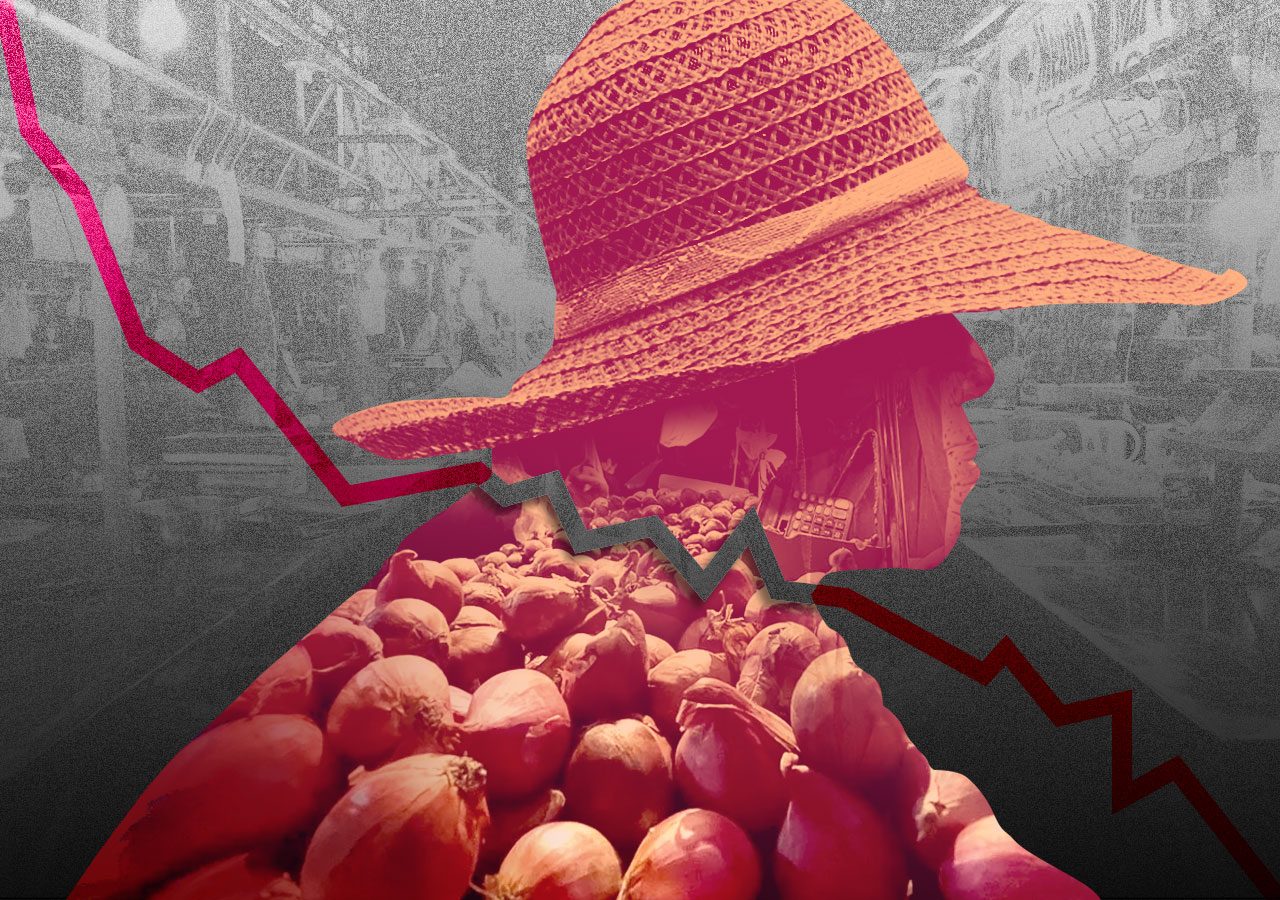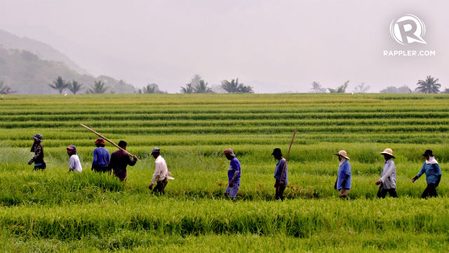SUMMARY
This is AI generated summarization, which may have errors. For context, always refer to the full article.

Trigger warning: This article contains references to suicide
MANILA, Philippines – Just days after Merlita Gallardo revealed in a Senate hearing that her husband, an onion farmer, took his own life in 2021 because an armyworm infestation had buried them in debt, cops came knocking on her door.
The police went to the widow’s home in Bayambang, Pangasinan, eight times in a span of two days, even as late as 11 pm. They asked her to sign a statement recanting her Senate testimony. Police authorities also prepared an affidavit, allegedly asking her to change her husband’s cause of death.
“I was scared because they kept coming back. I was worried,” Gallardo told DZBB.
The case of Gallardo’s husband is just one of five recorded suicides in the town, according to Elvin Laceda, national president of the Young Farmers Challenge Club of the Philippines, who also testified before the Senate committee on food and agriculture last January 16.
“I hope her story is never repeated among other farmers,” Laceda said.
Prior to the repeated police visits to Gallardo’s home, Bayambang Mayor Niña Jose-Quiambao disputed what some lawmakers dubbed as the onion suicides.
Jose-Quiambao cited data from the town’s health unit and police station, showing that there were no reports of multiple incidents of suicide amid skyrocketing onion prices in 2022.
The mayor, however, recognized the death of Gallardo’s husband in 2021. The police eventually apologized to Gallardo for causing fear, and said that they had no ill intention and simply wanted to validate the string of suicide incidents.
The incident in Pangasinan is perhaps the most extreme case that illustrates the disjoint between the Philippines’ glowing economic growth figures and the psychologically-challenging realities on the ground. It also reflects how ill-prepared the government is in handling a mental health crisis.
The Marcos administration’s economic team may have recently boasted that it exceeded its growth targets in 2022 at 7.6% – so far the highest in Asia – but sociologists and mental health workers are raising the alarm of a possibly dangerous contagion that could linger amid the pandemic.
In an economy still struggling to cope with inflation and mismanagement that often leads to financial losses of the poorest in society, the Philippine government cannot afford an inflation of hopelessness.
Self-harm and the economy
The Philippine Statistics Authority (PSA) reported that suicide incidents rose 25.7% to 3,529 in 2020, the 27th leading cause of death during the first year of the pandemic and the peak of the global recession. The figure is 34% higher than the average recorded from 2015 to 2020. (READ: Filipinos face the mental toll of the COVID-19 pandemic)
It is difficult to determine what drove people to end their lives during this period, as the PSA only recorded the cause of death in death certificates. The accuracy of what death certificates indicate can also be questioned, as suicide is often taboo. Suicides may therefore be grossly underreported, given the stigma.
Psychiatrists and other mental health professionals have likewise cautioned against attributing suicide to any single reason on trigger. Suicide is always a confluence of factors. Economic hardships are just one of the factors that may increase the risk of suicide.
Understanding how recessions and economic factors increase the risk of suicides is also tricky, as few social scientists, other than those in the field of psychology, have studied it in the Philippines.
Mark Quintos, among the few sociologists who have focused on suicidology in the Philippines, noted that sociological research on the topic is inherently difficult, partly due to the stigma of the act in a predominantly Christian society. Death certificates can sometimes hide this as well. Moreover, current literature is youth-focused, as datasets about the younger population are more easily accessible. These factors have effectively limited the understanding of suicide in the country.
Moreover, inquiries on the phenomenon of suicide are also often approached from a psychological perspective.
“The DSM (Diagnostic and statistical manual for mental disorders) sees suicide primarily as a result of psychiatric diagnoses such as major depressive disorder. Suicide, consequently, has been considered a mental problem, and efforts to resolve the problem focus on counseling or cognitive therapy. While there is merit in the approach used by our psychologist [colleagues], the perception that suicide is a mental health concern alone is very wanting,” Quintos said.
While Philippine data remain scarce, Quintos cited data from the United States Center for Disease Control and Prevention that around 54% of people in the US who died by suicide did not have a known mental health condition.
“This could either mean that they were undiagnosed prior to their death, or that there was nothing to diagnose and their suicide, rather than a mere mental health condition, is a consequence of bigger social forces at play,” he said.
From his own research, Quintos said that an adverse experience of being deprived of something that is needed or wanted, brought about by poverty, increases the risk of suicide. He also emphasized that poverty does not directly lead to suicides.
Exposure to suicide is a consistent risk factor for one’s own tendency to engage in suicidal behavior.
Mark quintos, sociologist
“Poverty, being a long-standing problem in the country, is already accepted as a normal part of the Filipino experience. Even among poor Filipino households. This is properly encapsulated in the quote that Filipinos often abide by: ‘Hindi mo kasalanan na ipinanganak kang mahirap, ngunit kasalanan mo kung mamamatay kang mahirap (It’s not your fault that you were born poor, but it’s your fault if you die poor),’” Quintos said.
Quintos added that onion farmers strive daily despite their poverty and hopes that their destiny will soon turn around. But when capital was diminished, frustration must have been too much to bear, as it also effectively took away control of their own destiny.
There is also the possibility of other sources of frustration piling up, such as the frustration of no longer finding meaning in the livelihood that they have chosen, as well as the frustration of not being able to adequately provide for their families.
Quintos also warned that one case of suicide can produce “social currents,” characterized as great emotional movements fueled by emotions such as indignation, pity, or misery.
“It is as if we are swept up by the emotions caused by the act, and we are pushed to do the same. We sometimes also call this contagion – wherein people, upon being exposed to a particular emotional stimulus such as suicide – tend to become influenced to do or engage in the same. This could explain why areas wherein a suicide has happened has a higher risk of having more suicide occurences. Indeed, in my studies, exposure to suicide is a consistent risk factor for one’s own tendency to engage in suicidal behavior,” he said.
Richthofen de Jesus, clinical psychologist of Empath, said that people may imitate self-destructive behavior because of vicarious learning.
“When a behavior is reinforced, if one sees someone being freed from debt by committing suicide, it can be imitated. It’s not automatic, but it increases the risk. Not all poor people commit suicide, of course. The personality type and coping mechanism are key factors in any decision-making and how people make sense of their situation,” De Jesus warned.
What the economic figures say
It’s hard to imagine the possibility of such a destructive social contagion, especially with economic numbers showing recovery.
The Philippines’ GDP growth surpassed the target at 7.6%, when government only aimed for at most 7.5%, primarily driven by household consumption. Filipinos were able to consume more despite inflation surging to as high as 8.1% in 2022.
Unemployment is also at an all-time low at 4.2% in November 2022, indicating that there are more employed Filipinos now than before the onset of the pandemic.
But these figures in 2022 do not tell the whole story.
For instance, farm output shrank 0.1% in 2022, the third consecutive year of contraction. This shows that while the services and industry sectors have reaped the benefits of the global economic reopening, onion farmers and many others in agriculture are still struggling to claw out of the pandemic’s financial impact.
Moreover, the country’s underemployment rate remained at double-digits at 14.4%, indicating that while more people found jobs, these jobs are of questionable quality and people need more hours of work to earn what’s needed to make ends meet.
The latest consumer expectations survey of the Bangko Sentral ng Pilipinas (BSP) revealed that Filipinos initially dipped into savings to fund the recent pickup in expenditure, but have since diverted funds to rebuild decimated savings.
The survey also indicated that households are tightening their belts after spending in 2022, and taking on less loans. ING Bank senior economist Nicholas Mapa earlier noted that this is an effect of the BSP’s interest rate hikes, which were done to anchor inflation.
Mapa also noted that in 2023, households will rebuild their savings and the so-called revenge spending will be reversed. Inflation will also remain elevated in 2023, further straining efforts to save and afford basic necessities.
More calling for help
The struggle to balance personal finances has also been observed by psychologists among their patients.
De Jesus said that during the pandemic, there were more patients who discontinued therapy sessions to siphon finances to other needs. The issue of debt has also been repeatedly cited as a stress point.
Finances is becoming a bigger piece of the pie that contributes to how the mental state of a person is constructed.
Richthofen De Jesus, clinical psychologist
De Jesus said that poor people, like farmers who get into debt first before they can start working, have an increased risk of self-destructive behavior.
“The common question is, ‘When will this end? Can I pay this off? What is the timeline?’ But as the pressure builds up repetitively, the person is not just seeing any sign of recovery,” De Jesus said.
For people to cope with debt-related frustration, De Jesus said that their support system should not downplay the struggles.
“Sometimes, people that you talk to about problems, because of the repetitive nature, they lose interest. And when you lose social support, you become crippled,” De Jesus said.
For Quintos, he sees better working conditions, not just mental health seminars, as a solution to a dangerous social contagion.
“In sociological literature, when people are frustrated, their response is to commit aggression. Suicide is just one side of the coin, with the other being homicide,” he said.
Quintos added: “In cultures wherein people are taught that their frustrations are due to their own faults, the tendency is for this aggression to be directed inward: They kill themselves. In cultures wherein people are taught that their frustrations are caused by forces outside of themselves, and where they see themselves as victims of these forces, they tend to aggress in an outward manner: killing other people in the process.” – Rappler.com
The Department of Health, through the National Center for Mental Health, has a national crisis hotline to assist people with mental health concerns. The hotline can be reached at 1553, which is a Luzon-wide, toll-free landline number, 0917-899-8727 and 0966-351-4518 for Globe and TM subscribers, and 0908-639-2672 for Smart and Sun subscribers.
Add a comment
How does this make you feel?

![[EDITORIAL] Apat na taon na lang Ginoong Marcos, ‘di na puwede ang papetiks-petiks](https://www.rappler.com/tachyon/2024/07/animated-bongbong-marcos-2024-sona-day-carousel.jpg?resize=257%2C257&crop=280px%2C0px%2C720px%2C720px)
![[In This Economy] Delulunomics: Kailan magiging upper-middle income country ang Pilipinas?](https://www.rappler.com/tachyon/2024/07/in-this-economy-upper-middle-income-country.jpg?resize=257%2C257&crop=421px%2C0px%2C1080px%2C1080px)

![[EDITORIAL] Marcos Year 2: Hilong-talilong](https://www.rappler.com/tachyon/2024/07/animated-bongbong-marcos-2nd-sona-carousel.jpg?resize=257%2C257&crop=136px%2C0px%2C720px%2C720px)
![[Newspoint] A fighting presence](https://www.rappler.com/tachyon/2024/07/thought-leaders-a-fighting-presence.jpg?resize=257%2C257&crop=441px%2C0px%2C1080px%2C1080px)
There are no comments yet. Add your comment to start the conversation.